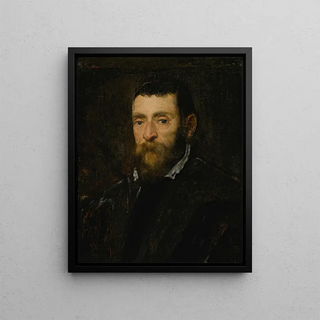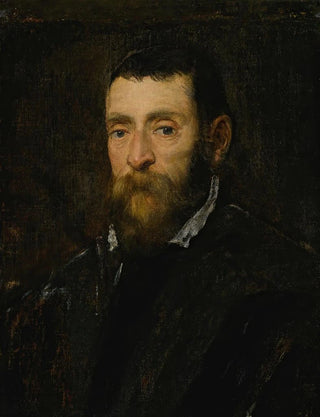Art print | Portrait of a bearded man, perhaps Prince Antonio di Santacroce of Rome - Jacopo Tintoretto


View from behind

Frame (optional)
Portrait of a bearded man, perhaps Prince Antonio di Santacroce of Rome - Jacopo Tintoretto – Captivating introduction
The art of the Italian Renaissance is a fascinating period, where artists captured the complexity of the human condition through vibrant and expressive portraits. Among these masters, Jacopo Tintoretto stands out for his boldness and innovation. The art print of his work "Portrait of a bearded man, perhaps Prince Antonio di Santacroce of Rome" offers a striking glimpse of his talent. This painting, rich in detail and emotion, evokes a time when portraiture was not merely a means of depicting a person but also a way to explore the psychology and social status of the individual portrayed.
Style and uniqueness of the work
The strength of this portrait lies in how Tintoretto manages to combine realism and idealization. The face of the bearded man, with its defined features and penetrating gaze, seems almost alive. The play of shadow and light, characteristic of Tintoretto's style, adds depth to the composition, emphasizing the contours of the face and the textures of the beard. The color palette, subtly nuanced, adds an emotional dimension to the piece. Every brushstroke, every meticulous detail, demonstrates the artist's skill in capturing not only the physical appearance but also the soul of his model. This portrait is a true invitation to contemplation, where each look reveals a new facet of the prince's personality.
The artist and his influence
Jacopo Tintoretto, born in Venice in 1518, is one of the emblematic figures of Renaissance painting. Often considered the last of the great Venetian masters, he distinguished himself with his bold style that combines dynamism and emotion. Tintoretto was influenced by artists such as Michelangelo and Titian, but he developed a unique approach marked by a constant search for movement and light. His work has not only left an indelible mark on his contemporaries but continues to inspire generations of artists. Exploring various themes, from portraits to religious scenes, Tintoretto redefined the

Matte finish

View from behind

Frame (optional)
Portrait of a bearded man, perhaps Prince Antonio di Santacroce of Rome - Jacopo Tintoretto – Captivating introduction
The art of the Italian Renaissance is a fascinating period, where artists captured the complexity of the human condition through vibrant and expressive portraits. Among these masters, Jacopo Tintoretto stands out for his boldness and innovation. The art print of his work "Portrait of a bearded man, perhaps Prince Antonio di Santacroce of Rome" offers a striking glimpse of his talent. This painting, rich in detail and emotion, evokes a time when portraiture was not merely a means of depicting a person but also a way to explore the psychology and social status of the individual portrayed.
Style and uniqueness of the work
The strength of this portrait lies in how Tintoretto manages to combine realism and idealization. The face of the bearded man, with its defined features and penetrating gaze, seems almost alive. The play of shadow and light, characteristic of Tintoretto's style, adds depth to the composition, emphasizing the contours of the face and the textures of the beard. The color palette, subtly nuanced, adds an emotional dimension to the piece. Every brushstroke, every meticulous detail, demonstrates the artist's skill in capturing not only the physical appearance but also the soul of his model. This portrait is a true invitation to contemplation, where each look reveals a new facet of the prince's personality.
The artist and his influence
Jacopo Tintoretto, born in Venice in 1518, is one of the emblematic figures of Renaissance painting. Often considered the last of the great Venetian masters, he distinguished himself with his bold style that combines dynamism and emotion. Tintoretto was influenced by artists such as Michelangelo and Titian, but he developed a unique approach marked by a constant search for movement and light. His work has not only left an indelible mark on his contemporaries but continues to inspire generations of artists. Exploring various themes, from portraits to religious scenes, Tintoretto redefined the






